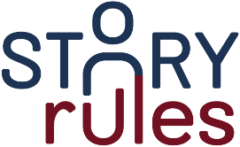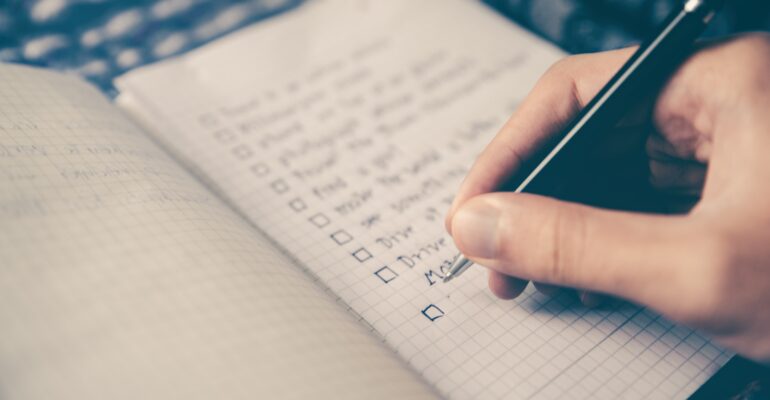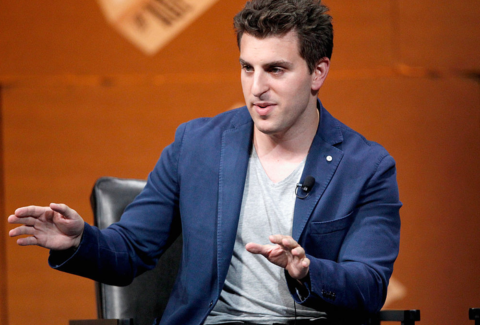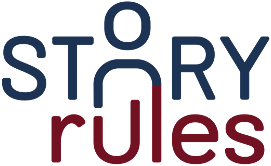Work From Home: Why you need to manage your T.E.A.M. and not just Time
Work-from-home (WFH) is great, innit?
No energy-draining commutes, no time-sucking meetings, no pesky co-worker conversations, no random birthday celebrations… and more family time… what’s not to love?
The dirty secret? For many of us, the office provides the necessary discipline to work. Actually work. And not fall prey to the three challenges of the home-office environment:
a. Distractions: Getting sucked into the unending temptations of the online universe (“Just one more video, and I’ll get back to work”) and other distractions.
b. Battling interruptions: Uniquely home interruptions such as the newspaper guy coming for his bill; the ironing guy for new clothes … and just when you are focusing on that critical proposal, a family member would ask for help with the printer. People assume that if you’re at home, you’re fair game and can be asked to do anything.
c. Managing low-energy periods: At office, the presence of others helps us power through the ‘low-energy’ periods (for instance that dreaded post-lunch nap, sorry dip, in productivity).
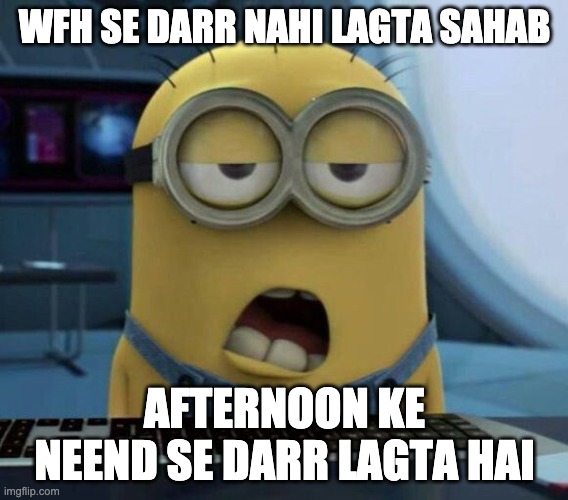
How can you cope?
In this long-form blog post, I’m sharing all the productivity lessons I’ve learnt from 8+ years of working from home.
(Disclaimer: There are much better sources of advice on this topic – for instance, the ‘Getting Things Done’ movement. I’m no expert on the topic. This is just a structured list of ideas that have worked for me).
Here’s a quick summary:
1. Break down your work into a prioritised list of tasks and record them
- Break down projects to bite-sized, SMART tasks
- Record tasks in the appropriate place based on urgency
- Prioritise them using the Creator-Clerk framework
2. Manage your T.E.A.M. (Time, Energy, Attention and Mood) to complete the tasks
- Time: Know your Biological Prime Time (BPT) and only schedule Creator tasks during this period
- Energy: Create a conducive office environment and sleep, eat and exercise well to maintain energy for critical tasks
- Attention: Know the sources of distraction and engineer your workplace to minimise its impact, especially during the BPT
- Mood: Avoid unnecessary conversations and keep your mood positive
Let’s begin.
1. Break down your work into a prioritised list of tasks and record them
a. Break down projects to bite-sized, SMART tasks
At work, you have two kinds of tasks. Simple one-off to-dos (e.g. book Pune-Delhi ticket) and more complex ‘projects’ (e.g. prepare client proposal).
You cannot work on a ‘project’. You can only work on tasks that make up a project. But we often list down a ‘project’ as a to-do in our task list … and then get stuck – where exactly to start?
For instance, can you identify which of the following items qualifies as a ‘task’:
- Research about healthcare in India
- Make a plan for the company offsite to Goa
- Complete auto-industry report
Answer: None of the above.
The above activities are all projects, that consist of a series of tasks within them. You need to break the project down into those tasks.
For instance, in the above cases, the following might be a specific task for each project:
- Download and read annual reports of top 3 healthcare companies (A, B and C)
- Speak to 3 vendors about Goa transport options and costs
- Put down thoughts for ‘Competition financial performance’ section in ‘Industry Overview’ chapter
When you are ‘breaking-down’ a project into component tasks, there are 2 guidelines to keep in mind:
- MECE: Between themselves, all the tasks should be MECE (Mutually-Exclusive-Collectively-Exhaustive)
- SMART: At the lowest level, the task should be unambiguous and SMART (Specific, Measurable, Assignable, Realistic and Time-bound)
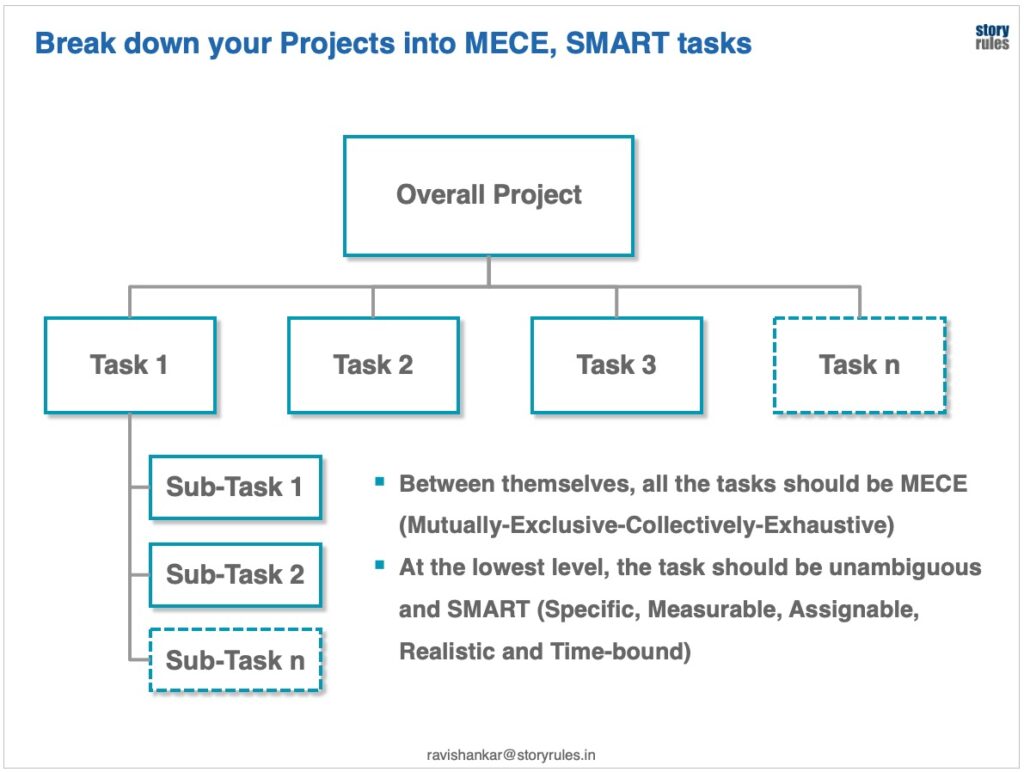
The actual steps in creating a detailed MECE task list is beyond the scope of this article, but suffice to say that you should have tasks, not projects in your to-do list.
b. Record tasks in the appropriate place based on urgency
Now tasks don’t arrive neatly in a package at 9 am every morning. They are an unruly barrage of items that come at you with no order or frequency. If you just keep responding to each one as they came, you’d never be able to get critical work done.
Which is why you need a recording system for your tasks and thoughts.
Over many years of experimenting, I have figured out a system that works for me. Depending on the category of the task and when it needs to get done (today or sometime in the future), I have the following recording system in place:
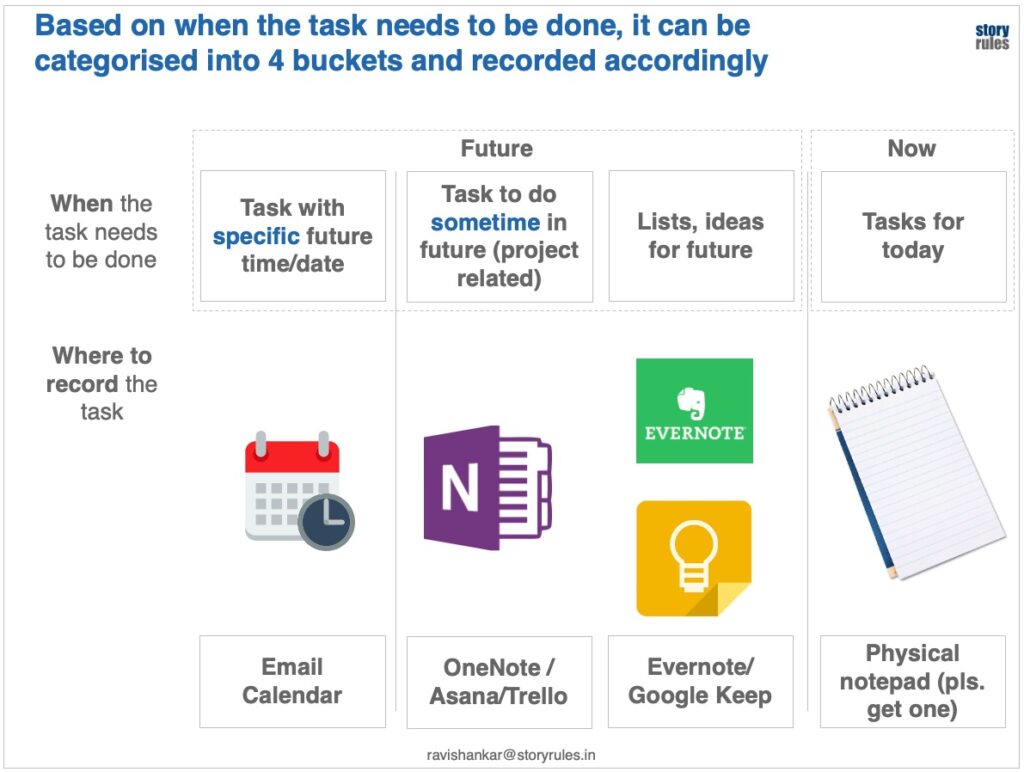
Elaborating on the above, here’s what I do for the different categories of tasks:
- For a meeting/call on a specific date or time, it’s easy – just record it on your calendar and then forget about it.
- For ideas or tasks on specific projects, it’s best to have a ‘structured-sink’ where you can drop these ideas into. If you are working collaboratively on a project, you can use tools like Trello, Asana, Wrike et al. (TBH, I haven’t worked on most of these, since I mostly work alone). For self-work, Microsoft OneNote is a good option to jot down notes.
- For future to-do lists or ideas on specific topics, I use Google Keep and Evernote. Keep is my generic note-taking tool, in which I have a range of notes, both personal and official – for e.g. my address and bank details for quick sharing, shopping lists, check-list for travel etc. On the other hand, I use Evernote almost exclusively for work ideas. I really like its ‘Notebooks’ feature and I use that to put down ideas by category. For example, the ‘Notebooks’ on my Evernote are given below:
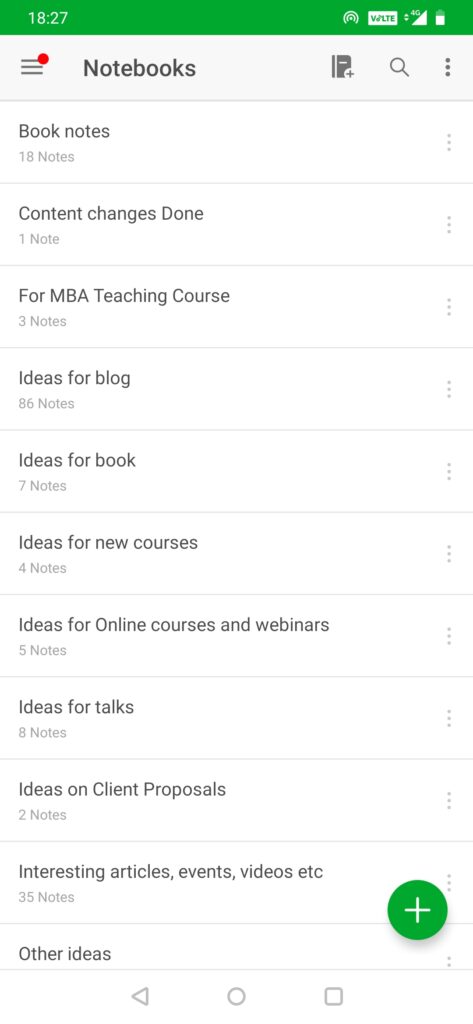
Physical Notepad: This is probably my most important task-management tool. Previously I would note down the day’s tasks in my normal work notebook. The issue with that is the work notebook also has a ton of other stuff – conversations notes, thoughts for a presentation, doodles etc. It then becomes difficult to flip back and look for your to-do list, among all the other notes. That’s when I decided to buy some small notepads – which I exclusively use for the day’s tasks only. That makes it easy to find the to-do list for the day and previous days. And it enables you the satisfaction of ‘ticking things off’ the list!
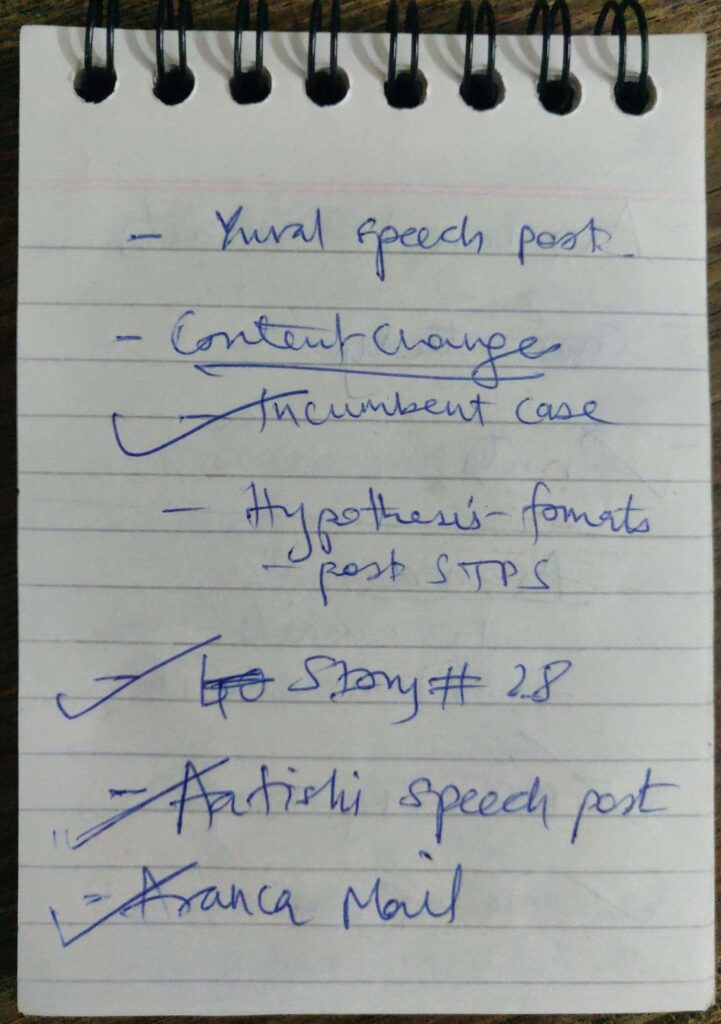
Alright, so you have your list of activities for the day. Time to get cracking? Not yet. You need to categorise them into Creator and Clerk tasks first.
c. Prioritise tasks using the Creator-Clerk framework and urgency
Not all tasks are equally important. While we know that instinctively, we don’t follow that priority when executing them.
Way back in 2009, Y-Combinator founder Paul Graham had penned a famous essay: Maker’s Schedule, Manager’s Schedule. In it, he categorised all tasks into two – Maker tasks, which add most value and Manager tasks, which need to be done but aren’t value-generating of themselves.
I call them Creator and Clerk tasks, to make the distinction clearer. Creator tasks are what get you paid – writing a proposal, making a project plan, creating a presentation.
Clerk tasks are the routine everyday items that take up a lot of time but are not the reason you get paid. E.g. Filling time-sheets, expense reports, responding to routine emails.
Here’s an illustrative list of Creator and Clerk tasks to make the distinction clearer:
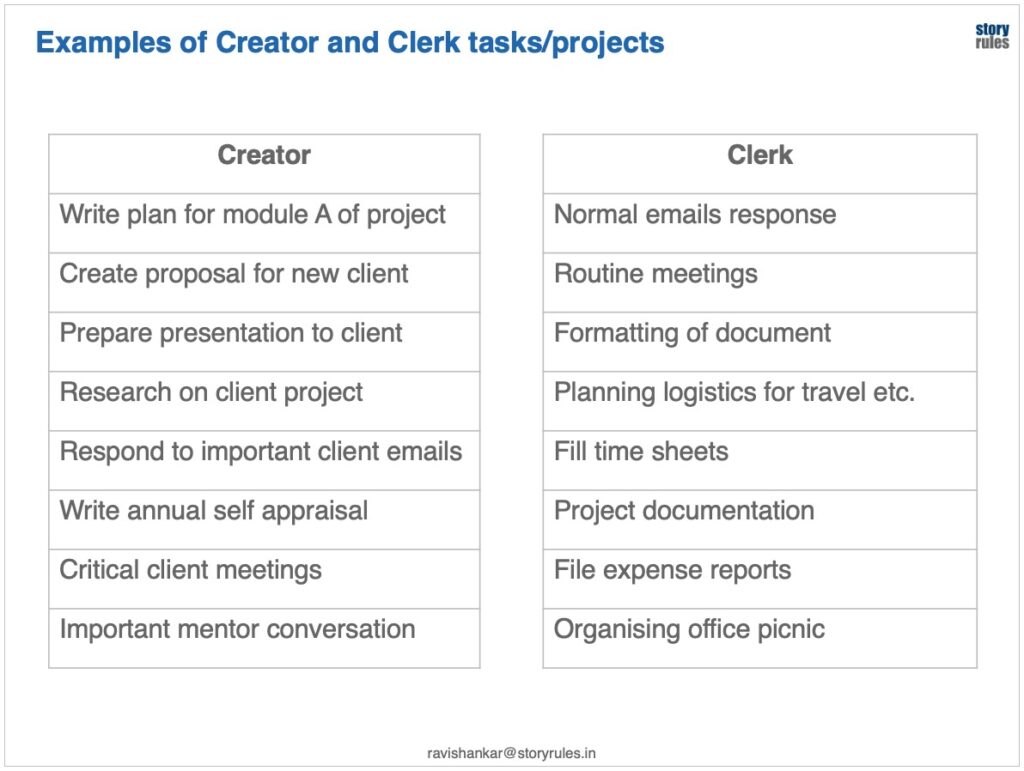
Once you have the list of tasks to be done, you need to classify them into these two categories.
And then comes the important step: At the beginning of each work-day, list down no more than three Creator tasks that you would like to accomplish for that day.
More than three would make it too ambitious and set you up for disappointment; less than three might be too easy.
Once you’ve categorised your task, we move onto the next section: using our resources – our T.E.A.M. – to complete the tasks.
2. Manage your T.E.A.M. (Time, Energy, Attention and Mood) to complete the tasks
That’s right – just managing your time isn’t good enough. You may have all the time in the world, but still not get any work done, because:
- You were distracted (low attention)
- You were low on energy, or
- You were in a low mood
Which means you need to manage all your resources impacting productivity – your time, energy, attention and mood.
Let’s dive in.
a. Time: Schedule Creator tasks during your Biological Prime Time (BPT) and take frequent restorative breaks
In limited-overs cricket, the Power-Play is a critical phase. During this period, there are restrictions on how many fielders can be outside the circle – which gives the batsmen a freer license to take risks and score more.
Of course, that means you need to send the right batsman during this period. You would send a Virat Kohli or a Rohit Sharma; and not a Jasprit Bumrah or a Yuzvendra Chahal.
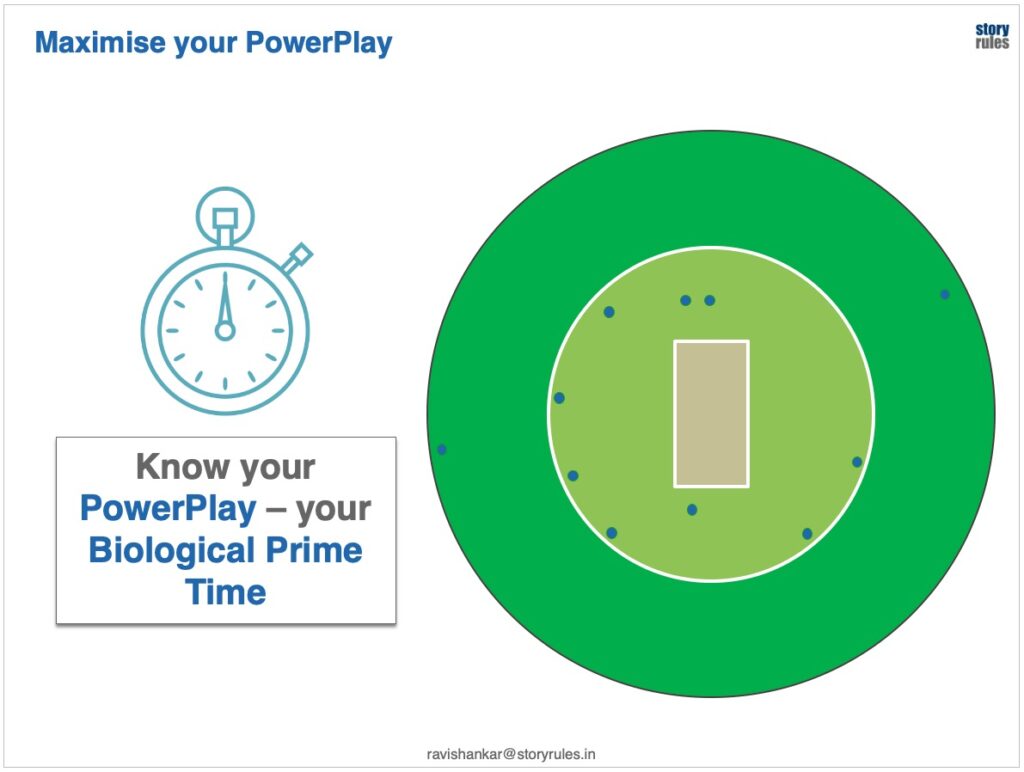
Similarly, during your day you have a PowerPlay time – it’s called your Biological Prime Time: the time of the day when you are most alert and raring to go. Typically it’s the first 2-3 hours when you start work in the morning (for some it may be the evening time; for others, it may be two slots across the day).
Now here’s the thing: During this period, if you end up doing ‘Clerk’ tasks, you would be frittering away your BPT advantage. It’d be like sending Bumrah (no offence!) during your batting PowerPlay.
So the key ‘time’-management trick to maximise your productivity: Schedule your Creator tasks during your BPT.
For instance, I would start my morning with any proposals that need to be sent, any research that needs to be done for an upcoming session or any writing for the blog.
Late mornings and afternoons would be for the mundane stuff – accounting, paying bills and taxes, booking flights and hotels. I try and keep my BPT free from such items.
Of course, this is easier said than done because of 2 issues:
- Yourself: Often we are tempted to start work in the morning with simple Clerk tasks (like clearing all unread emails to “get them out of the way”). It may give you a sense of accomplishment, but it’s a poor use of your BPT, since your Creator tasks remain undone. It may also happen that we start off on a Creator task, but get stuck in between. That’s when one part of us says “Hey, forget this difficult job – there are so many easier things to do in your list. If you work on them, at least you’ll be ticking them off your list”. Avoid the temptation. Creator tasks are meant to be difficult. Power through them, and you’ll come up something impactful. If needed, take a 5-minute, non-screen break… but don’t give up.
- Other people: You know your BPT. But others don’t. And so there are likely to be multiple interruptions from your boss, colleagues, family members (at home)… How to cope? Identify the most common interrupters and politely request them to hold off their queries for a couple of hours. Better still, tell everyone upfront that you are going to be busy from X to Y time period and it’ll be best for them to hold off any non-critical questions till later.
Make the most of your BPT.
Divvy-up your BPT into smaller time-slots: Your Creator task should not be a large 2-hour lump of work. Break it down into smaller pieces. One approach that works here is the Pomodoro technique: you work in 25-minute intervals and take 3-5 minute breaks in between. This site gives an easy tool to implement this technique. In my own case, I break down my BPT into 30-45 min slots, with short breaks in between.
Go easy on yourself during the non-BPT: Conversely, go easy on yourself during the non-Prime time. Recognise that you can’t work non-stop for 8 hours at home. Which brings us to the next point: breaks.
Take frequent breaks. Now, a break doesn’t mean watching a video or catching up on your social media feed. You need to take restorative breaks – that enable you to come back to work refreshed.
For a break to be restorative, here are some tips from Daniel Pink’s ‘When: The Scientific Secrets of Perfect Timing’. According to him, breaks should be:
- Short but frequent: You can time them using the Pomodoro technique
- Moving not stationary: Go for a short walk
- Social not solo: Have a quick conversation, preferably not about work
- Outside not inside: Nature works best
- Fully detached: No smartphones!
So, on Time: Focus on your BPT, go easy during non-BPT and take frequent, restorative breaks.
You may have the time, but what if you don’t ‘feel’ like working? We move onto resource #2: Energy.
b. Energy: Sleep, eat and exercise well to maintain energy for critical tasks
You need to acknowledge that your energy would dip during some parts of the day (that dreaded post-lunch period). What can you do? Three things:
One, do the basics right to get adequate energy for work. Get 7-8 hours of sleep, exercise and eat right. Also, designate one separate place as your workstation at home. Ideally not something comfortable like a lounge chair or sofa. Invest in a good work-chair and table, if you don’t have one. You’re gonna use it a lot going forward!
Two, smartly use deadlines and end-points. Our minds work faster when faced with a deadline, or when we perceive to be close to completion. Which means that you can ‘program’ your mind to be more enthused about work – by breaking your entire project into smaller components, each with its own deadline and end-point.
Three, acknowledge that you will struggle in some periods of the day.
And now, the next piece of advice I’m going to give would be blasphemous to some and music-to-the-ears to many: It’s ok to take a short afternoon nap.
What?! A nap during work-time? That’s terrible, you may think.
But it makes a lot of sense according to the aforementioned Dan Pink book. In fact, he suggests a 5-step process to ‘nap right’. He calls it the nappuccino (because you’re supposed to have a cup of coffee before you nap! The coffee takes about 25 mins to enter your bloodstream and that is adequate time for your nap). You don’t have to lie down on a bed – a nap can also be a quick shut-eye on your desk or sofa.
Recognise that you have differing energy levels at home as compared to office (because of the lack of social interaction). Plan accordingly and you’ll have a productive day.
Energy is still relatively easy to manage though – we now move on to the most tricky challenge: distraction.
c. Attention: Know the sources of distraction and engineer your workplace to minimise its impact, especially during the BPT
The biggest challenge of WFH is managing distractions. Unfortunately, they are all-pervasive and increasing in intensity. Distractions are especially worrisome when they hit us during our critical Creator tasks.
To cope with this problem, you need to break it down into smaller component parts.
Here’s a framework that I have created to classify distraction:
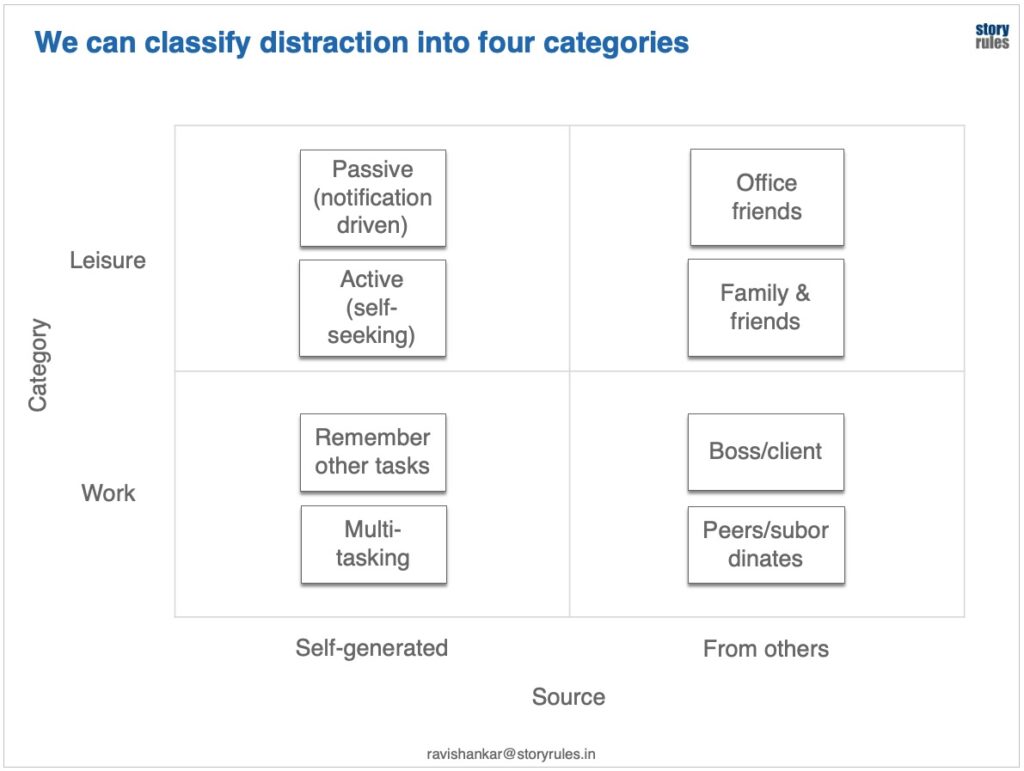
So distraction can be categorised on 2 axes – based on its nature (work-related or leisure) and its source (self-generated or from others).
Let’s take the first category: Work-related distraction. These could be you remembering to book your tickets (while in the middle of a Creator Task), your colleague pinging you for some old proposal or your boss asking you for some mundane clarification.
Here are the types of work-related distraction and how you can combat them:
Self-generated work-related distractions
- When you remember another small task while doing a Creator task: Unless it’d take less than a minute, avoid the temptation to “quickly” finish off the small task/s. It’s not about how much time it will take. It’s about not letting your attention (and your subconscious mind) divert its focus away from the Creator task. If you remember another task, just record it in the right place (see point 1-b above). Writing down the task means that it’s no longer taking up your mind-space. Time to get back to the critical task at hand.
- When you multi-task: We all fall prey to the temptation of multi-tasking. While many of us pride our ‘multi-tasking’ skills, the science is clear on this: we are less effective when we multitask. Or better, check out this hilarious clip from the peerless Modern Family, when Phil displays his ADHD!
Others-generated work-related distractions
- Boss/client: If there’s one source of distraction that you can’t do much about it’s your boss or client asking you for some information when you are in the middle of something. You could, of course, politely tell them that you’ll get back – but it may not always be possible. I would suggest two remedies. One, build some buffer for such unavoidable interruptions in your day-plan. Two, request for lesser interruptions during your BPT, by reframing the situation. For instance, instead of saying “Please don’t disturb me from 9 to 10.30 every day” you could say – “Can I please request for some quiet time every day from 9-10.30 am? It would help in generating better solutions for our project!”
- Colleagues/subordinates: With colleagues, we feel peer-pressure to respond as soon as something is asked for. You don’t need to do that! Politely indicate to them the time period when you are busy and request them to hold off their questions for later. During this period, switch off from the communication channels such as chat, Whatsapp etc.
Here’s a visual summary of how to cope with work-related distractions:
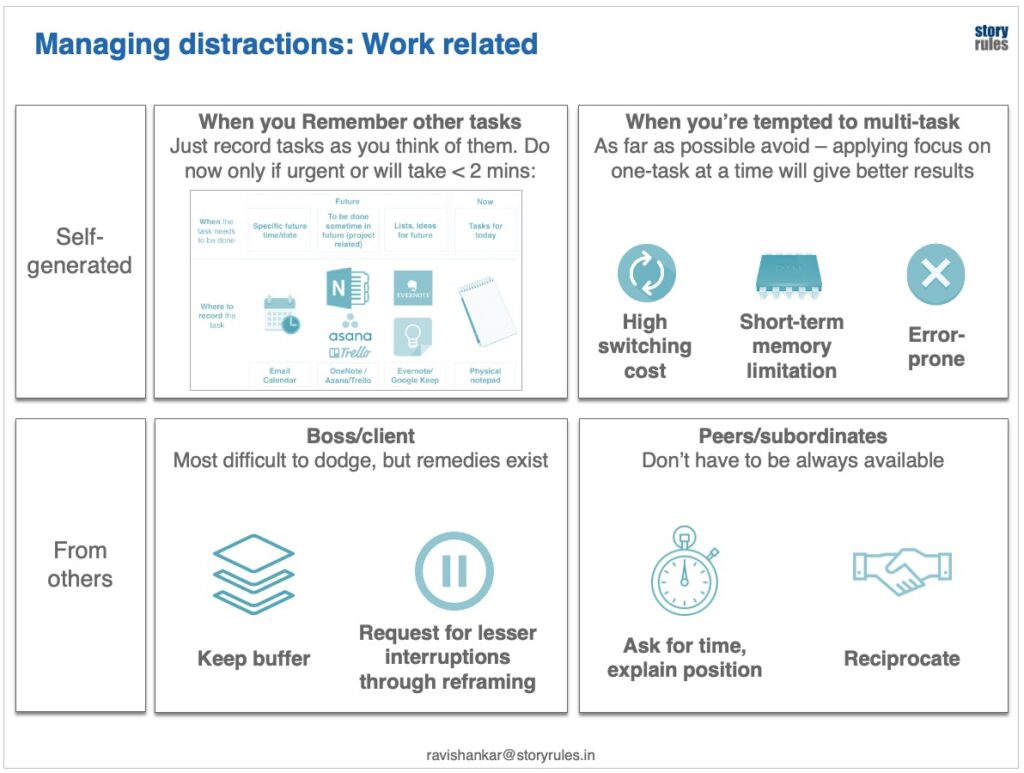
Managing work-related distractions is not easy, especially when the boss is involved. But the remedies are still easier than the big one: managing leisure distractions.
Self-generated leisure distractions
Let’s face it. Work can be boring. Creator tasks can be tough. And there’s no harm in watching just one more ‘Key and Peele’ video, reading one more Cricinfo article, or one more Instagram story.
Trust me, I’ve been there. The moment I’d get stuck on a tough proposal or a mundane expense report, my hands would instinctively reach for the ‘Alt-Tab’ key and begin scrolling through the endless joys of the internet.
I’ve listed below some of the tactics that have worked for me – but make no mistake: This is a constant battle and it never gets easier.
I categorise leisure distractions into two categories:
a. Passive interruptions: You are working on the final deck. Your phone pings. It’s a funny link on Covid-19. You open it. 2-hours later you emerge from the internet rabbit-hole, shame-faced. The worst part: you were actually working without any need for distraction! That’s the insidious nature of distraction – it pulls you in, even when you don’t want to. Here are some strategies I have tried:
- Turn off ALL sound and vibration notifications on your phone, except for calls
- Do the smartphone asana. Take your phone, and place it face down on your desk. This simple trick will stop you from getting distracted by the dim blinking notifications light. If possible, keep the phone in another room!
- For distractions on the computer, it’s trickier. If possible switch off notifications from chats and emails for brief periods of time when you want to concentrate and work (say, your Pomodoro time).
- Desperate measures: I had once installed an app called Freedom on my laptop. With this, you can block certain sites (for example all social media sites, Youtube, Rediff, Cricinfo etc.) for certain blocks of time – essentially during your BPT. It’s a drastic measure, but my problem was no less drastic!
b. Active interruptions: This is when you actively seek out entertainment options when working. Your coping tactic would depend on the source of the distraction:
- Difficult/unstructured task: We have mentioned before that you cannot work on a project – you can only work on a task. If your task is too difficult or unstructured (e.g. Work on final report) you may be stuck… and a stuck mind looks for escape which the internet provides. One way out is to break-down the project into SMART tasks and start on any one task. Or you could discuss the project with a senior/colleague. Don’t hesitate to ask for help!
- Boring: Sometimes you may get distracted if the task is ultra boring (e.g. expense reports, time-sheets!). I’ve found that two things work – you can gamify it (How many can you get done in 15 mins!) or temptation bundle it. One of my favourite temptations: put on some of my favourite Rahman albums and get immersed in them with my Sennheiser headphones*.
- Lacking meaning: If you aren’t finding meaning in your work, your mind would constantly throw distractions at you. In that case, you can try to make your ‘non-meaningful’ task meaningful by connecting it with the outcome and its impact on the end-user. Tell yourself – “I’m not just writing some lines of code, I’m building a tool that people can use to make their lives easier”. If you still can’t see meaning in your work, then perhaps you need to question if it’s the right place for you!
Others-generated leisure distractions
While the vast majority of leisure distractions are self-generated, there would be others-generated distractions too.
- From office friends/colleagues: The chances of these happening in a WFH situation is lower, since no one will travel from Andheri to Thane for a sutta break with a friend. But with chat apps, Whatsapp et al, there’s enough scope for distraction. For the sake of popularity, don’t lose your productivity. Learn to say the magical two-letter word (No!) and if at all, schedule breaks on mutual convenience.
- From family: Inform them about your schedule, especially your BPT. But (and here’s the tough part) you need to respect your schedule as much as them. Make the most of your time saved from the commute – and schedule more time with family – you owe them your presence!
Here’s a visual summary of how to cope with leisure-related distractions:
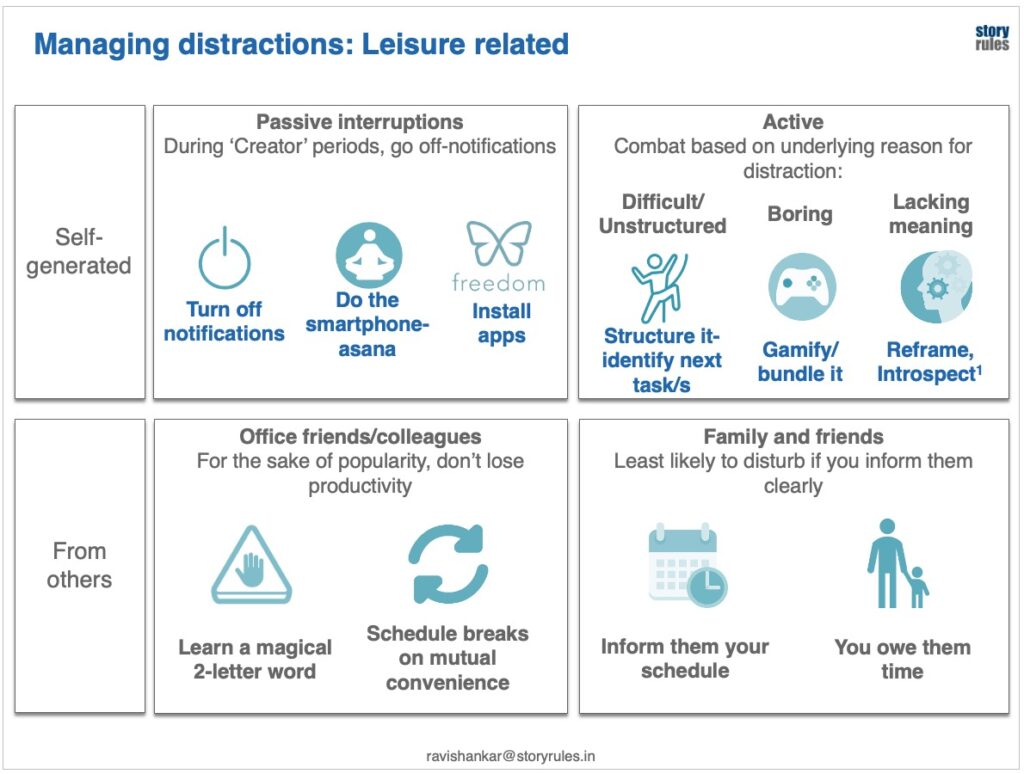
d. Mood: Avoid unnecessary conversations and keep your mood positive
The final factor which impacts work is your mood. Despite having the time, the attention and the energy, you may still not be able to work – because of negative emotions flooding your mind.
Now this is a vast topic by itself, but I’m going to do a quick overview of the reasons:
a. Work-related mood-dampeners: We all have ‘difficult’ work interactions – with our boss or other colleagues. Some folks are able to compartmentalise and get on with the task at hand; while others (including yours truly) let it fester and ruminate in their mind, impacting their work. How to cope? Slightly beyond the scope of this article, but here’s a quick question that you can ask: Is it a one-off incident … or forming a pattern indicating a toxic relationship?
- If it’s the former, you should communicate with the person about your concern and how you can avoid it going forward
- If it’s the latter, you should consider whether to continue with the company/relationship.
b. Mood-dampeners arising from outside work: This could be a situation at home – which is beyond the scope of this article. What I’d like to focus on here are the toxic interactions that arise from non-family-non-work sources. Essentially conversations with friends and those online. Let me be more specific: Conversations on Whatsapp, Twitter and Facebook.
- Twitter: Ah, Twitter. The place where the internet goes to get angry. I’ve wasted many hours learning the various ways in which I should be getting outraged about the world… I used to tell myself that it was important for work… until I realised that I was just spoiling my mood reading it. And so, about a year ago, I quit Twitter (despite being an incessant user). And no – the world didn’t come crashing down. Unless it’s a part of your job, I don’t see any reason for using Twitter.
- Whatsapp: Whatsapp is critical for communication – but the groups are the challenge. Ever so often, some political discussion would break out in a group. For every 10-minutes wasted reading or typing in the group, you might end up wasting almost 3X that amount thinking about it. And adversely impacting your work… The worst part? No one’s opinions would have changed after reading your carefully constructed arguments. And so, about 3 months back, I left all Whatsapp groups except for close family and logistics related. Again, I’m not missing anything.
- Facebook: What are you still doing there?
Here’s a chronicle of my journey of reducing smartphone usage. It’s still an uphill battle… but it’s far better than what it was.
So there you have it – my life learnings on enhancing work productivity by managing your T.E.A.M. better. Here’s the quick summary again as a recap:
1. Break down your work into a prioritised list of tasks and record them
- Break down projects to bite-sized, SMART tasks
- Record tasks in the appropriate place based on urgency
- Prioritise them using the Creator-Clerk framework
2. Manage your T.E.A.M. (Time, Energy, Attention and Mood) to complete the tasks
- Time: Know your Biological Prime Time (BPT) and only schedule Creator tasks during this period
- Energy: Create a conducive office environment and sleep, eat and exercise well to maintain energy for critical tasks
- Attention: Know the sources of distraction and engineer your workplace to minimise its impact, especially during the BPT
- Mood: Avoid unnecessary conversations and keep your mood positive
Please share any other tips or tricks that have worked for you in the comments and I will publish some of the best ones in a separate post.
Here’s a list of books that have guided me through this challenging productivity journey:
- When: The Scientific Secrets of Perfect Timing by Daniel Pink
- Deep Work and Digital Minimalism (both) by Cal Newport
- Getting Things Done: The Art of Stress-Free Productivity by David Allen
- Atomic Habits by James Clear
- The Power of Habit by Charles Duhigg
- The Productivity Project by Chris Bailey
*****
Featured image credit: Photo by Glenn Carstens-Peters on Unsplash
* Some of you may be wondering: Isn’t listening to music while working “multi-tasking”? According to me, it isn’t, unless you are actively trying to understand the lyrics etc. If you’re just listening to music in the background, then only one of your activities (your work) is causing you active mental strain. Real multi-tasking is when we juggle 2 or more activities (at the same time) each of which take up some active mental bandwidth
